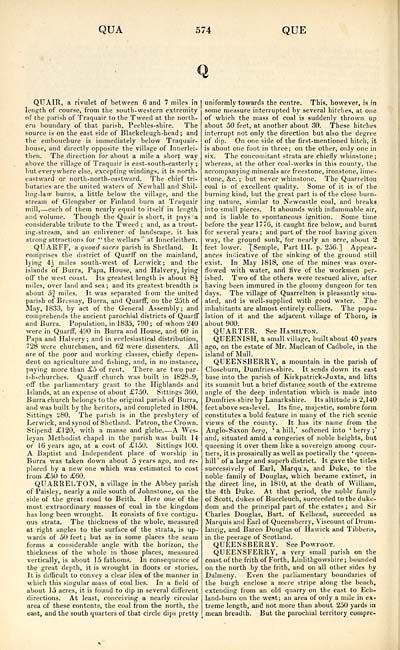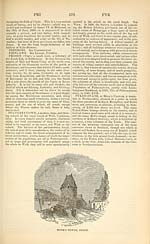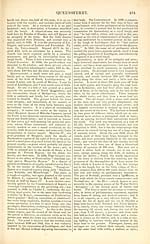Topographical, statistical, and historical gazetteer of Scotland > Volume 2
(590) Page 574
Download files
Complete book:
Individual page:
Thumbnail gallery: Grid view | List view

QUA
574
QUE
QTJAIR, a rivulet of between 6 and 7 miles in
length of course, from the south-western extremity
of the parish of Traquair to the Tweed at the north-
ern boundary of that parish, Peebles-sbire. The
source is on the east side of Blackcleugh-head ; and
the embouchure is immediately below Traquair-
liouse, and directly opposite the village of Innerlei-
then. The direction for about a mile a short way
above the village of Traquair is east-south-easterly ;
but everywhere else, excepting windings, it is north-
eastward or north-north-eastward. The chief tri-
butaries are the united waters of Newhall and Shil-
ling-law burns, a little below the village, and the
stream of Glengaber or Finland burn at Traquair
mill, — each of them nearly equal to itself in length
and volume. Though the Quair is short, it pays a
considerable tribute to the Tweed ; and, as a trout-
ing-stream, and an enlivener of landscape, it has
strong attractions for "the wellars" at Innerleithen.
QUARFF, a quoad sacra parish in Shetland. It
comprises the district of Quarff on the mainland,
lying 4i miles south-west of Lerwick; and the
islands of Burra, Papa, House, and Halvery, lying
off the west coast. Its greatest length is about 8J
miles, over land and sea; and its greatest breadth is
about 5} miles. It was separated from the united
parish of Bressay, Burra, and Quarff, on the 25th of
May, 1833, by act of the General Assembly; and
comprehends the ancient parochial districts of Quarff
and Burra. Population, in 1835, 790; of whom 240
were in Quarff, 490 in Burra and House, and 60 in
Papa and Halvery ; and in ecclesiastical distribution,
728 were churchmen, and 62 were dissenters. All
are of the poor and working classes, chiefly depen-
dent on agriculture and fishing, and, in no instance,
paying more than £5 of rent. There are two par-
ish-churches. Quarff church was built in 1828-9,
off the parliamentary grant to the Highlands and
Islands, at an expense of about £750. Sittings 360.
Burra church belongs to the original parish of Burra,
and was built by the heritors, and completed in 1804.
Sittings 280. The parish is in the presbytery of
Lerwick, and synod ot Shetland. Patron, the Crown.
Stipend £120, with a manse and glebe A Wes-
leyan Methodist chapel in the parish was built 14
or 16 years ago, at a cost of £150. Sittings 100.
A Baptist and Independent place of worship in
Burra was taken down about 5 years ago, ami re-
placed by a new one which was estimated to cost
from £50 to £60.
QUARRELTON, a village in the Abbey parish
of Paisley, nearly a mile south of Johnstone, on the
side of the great road to Beith. Here one of the
most extraordinary masses of coal in the kingdom
has long been wrought. It consists of rive contigu-
ous strata. The thickness of the whole, measured
at right angles to the surface of the strata, is up-
wards of 50 feet ; but as in some places the seam
forms a considerable angle with the horizon, the
thickness of the whole in those places, measured
vertically, is about 15 fathoms. In consequence of
the great depth, it is wrought in floors or stories.
It is difficult to convey a clear idea of the maimer in
which this singular mass of coal lies. In a field of
about 15 acres, it is found to dip in several different
directions. At least, conceiving a nearly circular
area of these contents, the coal from the north, the
east, and the south quarters of that circle dips pretty
uniformly towards the centre. This, however, is in
some measure interrupted by several hitches, at one
of which the mass of coal is suddenly thrown up
about 50 feet, at another about 30. These hitches
interrupt not only the direction but also the degree
of dip. On one side of the first-mentioned hitch, it
is about one foot in three; on the other, only one in
six. The concomitant strata are chiefly whins tone;
whereas, at the other coal -works in this county, the
accompanying minerals are freestone, ironstone, lime-
stone, &c. ; but never whinstone. The Quarrelton
coal is of excellent quality. Some of it is of the
burning kind, but the great part is of the close burn-
ing nature, similar to Newcastle coal, and breaks
into small pieces. It abounds with inflammable air,
and is liable to spontaneous ignition. Some time
before the year 1776, it caught fire below, and burnt
for several years; and part of the roof having given
way, the ground sunk, for nearly an acre, about 2
feet lower. [Semple, Part III. p. 256.] Appear-
ances indicative of the sinking of the ground still
exist. In May 1818, one of the mines was over-
flowed with water, and five of the workmen per-
ished. Two of the others were rescued alive, after
having been immured in the gloomy dungeon for ten
days. The village of Quarrelton is pleasantly situ-
ated, and is well-supplied with good water. The
inhabitants are almost entirely colliers. The popu-
lation of it and the adjacent village of Thorn, is
about 900.
QUARTER. See Hamilton.
QUEENISH, a small village, built about 40 years
ago, on the estate of Mr. Maclean of Cadbole, in the
island of Mull.
QUEENSBERRY, a mountain in the parisb of
Closeburn, Dumfries-shire. It sends down its east
base into the parish of Kirkpatrick-Juxta, and lifts
its summit but a brief distance south of the extreme
angle of the deep indentation which is made into
Dumfries-shire by Lanarkshire. Its altitude is 2,140
feet above sea-level. Its fine, majestic, sombre form
constitutes a bold feature in many of the rich scenic
views of the county. It has its name from the
Anglo-Saxon bery, ' a hill,' softened into ' berry ;'
and, situated amid a congeries of noble heights, but
queening it over them like a sovereign among cour-
tiers, it is prosaically as well as poetically the ' queen-
hill ' of a large and superb district. It gave the titles
successively of Earl, Marquis, and Duke, to the
noble family of Douglas, which became extinct, in
the direct line, in 1810, at the death of William,
the 4th Duke. At that period, the noble family
of Scott, dukes of Buccleuch, succeeded to the duke-
dom and the principal part of the estates; and Sir
Charles Douglas, Bart, of Kelhead, succeeded as
Marquis and Earl of Queensberry, Viscount of Drum-
lanrig, and Baron Douglas of Hawick and Tibberis,
in the peerage of Scotland.
QUEENSBERRY. See Powfoot.
QUEENSFERRY, a very small parish on the
coast of the frith of Forth, Linlithgowshire; bounded
on the north by the frith, and on all other sides by
Dalmeny. Even the parliamentary boundaries of
the burgh enclose a mere stripe along the beach,
extending from an old quarry on the east to Ech-
land-burn on the west; an area of only a mile in ex-
treme length, and not more than about 250 yards in
mean breadth. But the parochial territory compre-
574
QUE
QTJAIR, a rivulet of between 6 and 7 miles in
length of course, from the south-western extremity
of the parish of Traquair to the Tweed at the north-
ern boundary of that parish, Peebles-sbire. The
source is on the east side of Blackcleugh-head ; and
the embouchure is immediately below Traquair-
liouse, and directly opposite the village of Innerlei-
then. The direction for about a mile a short way
above the village of Traquair is east-south-easterly ;
but everywhere else, excepting windings, it is north-
eastward or north-north-eastward. The chief tri-
butaries are the united waters of Newhall and Shil-
ling-law burns, a little below the village, and the
stream of Glengaber or Finland burn at Traquair
mill, — each of them nearly equal to itself in length
and volume. Though the Quair is short, it pays a
considerable tribute to the Tweed ; and, as a trout-
ing-stream, and an enlivener of landscape, it has
strong attractions for "the wellars" at Innerleithen.
QUARFF, a quoad sacra parish in Shetland. It
comprises the district of Quarff on the mainland,
lying 4i miles south-west of Lerwick; and the
islands of Burra, Papa, House, and Halvery, lying
off the west coast. Its greatest length is about 8J
miles, over land and sea; and its greatest breadth is
about 5} miles. It was separated from the united
parish of Bressay, Burra, and Quarff, on the 25th of
May, 1833, by act of the General Assembly; and
comprehends the ancient parochial districts of Quarff
and Burra. Population, in 1835, 790; of whom 240
were in Quarff, 490 in Burra and House, and 60 in
Papa and Halvery ; and in ecclesiastical distribution,
728 were churchmen, and 62 were dissenters. All
are of the poor and working classes, chiefly depen-
dent on agriculture and fishing, and, in no instance,
paying more than £5 of rent. There are two par-
ish-churches. Quarff church was built in 1828-9,
off the parliamentary grant to the Highlands and
Islands, at an expense of about £750. Sittings 360.
Burra church belongs to the original parish of Burra,
and was built by the heritors, and completed in 1804.
Sittings 280. The parish is in the presbytery of
Lerwick, and synod ot Shetland. Patron, the Crown.
Stipend £120, with a manse and glebe A Wes-
leyan Methodist chapel in the parish was built 14
or 16 years ago, at a cost of £150. Sittings 100.
A Baptist and Independent place of worship in
Burra was taken down about 5 years ago, ami re-
placed by a new one which was estimated to cost
from £50 to £60.
QUARRELTON, a village in the Abbey parish
of Paisley, nearly a mile south of Johnstone, on the
side of the great road to Beith. Here one of the
most extraordinary masses of coal in the kingdom
has long been wrought. It consists of rive contigu-
ous strata. The thickness of the whole, measured
at right angles to the surface of the strata, is up-
wards of 50 feet ; but as in some places the seam
forms a considerable angle with the horizon, the
thickness of the whole in those places, measured
vertically, is about 15 fathoms. In consequence of
the great depth, it is wrought in floors or stories.
It is difficult to convey a clear idea of the maimer in
which this singular mass of coal lies. In a field of
about 15 acres, it is found to dip in several different
directions. At least, conceiving a nearly circular
area of these contents, the coal from the north, the
east, and the south quarters of that circle dips pretty
uniformly towards the centre. This, however, is in
some measure interrupted by several hitches, at one
of which the mass of coal is suddenly thrown up
about 50 feet, at another about 30. These hitches
interrupt not only the direction but also the degree
of dip. On one side of the first-mentioned hitch, it
is about one foot in three; on the other, only one in
six. The concomitant strata are chiefly whins tone;
whereas, at the other coal -works in this county, the
accompanying minerals are freestone, ironstone, lime-
stone, &c. ; but never whinstone. The Quarrelton
coal is of excellent quality. Some of it is of the
burning kind, but the great part is of the close burn-
ing nature, similar to Newcastle coal, and breaks
into small pieces. It abounds with inflammable air,
and is liable to spontaneous ignition. Some time
before the year 1776, it caught fire below, and burnt
for several years; and part of the roof having given
way, the ground sunk, for nearly an acre, about 2
feet lower. [Semple, Part III. p. 256.] Appear-
ances indicative of the sinking of the ground still
exist. In May 1818, one of the mines was over-
flowed with water, and five of the workmen per-
ished. Two of the others were rescued alive, after
having been immured in the gloomy dungeon for ten
days. The village of Quarrelton is pleasantly situ-
ated, and is well-supplied with good water. The
inhabitants are almost entirely colliers. The popu-
lation of it and the adjacent village of Thorn, is
about 900.
QUARTER. See Hamilton.
QUEENISH, a small village, built about 40 years
ago, on the estate of Mr. Maclean of Cadbole, in the
island of Mull.
QUEENSBERRY, a mountain in the parisb of
Closeburn, Dumfries-shire. It sends down its east
base into the parish of Kirkpatrick-Juxta, and lifts
its summit but a brief distance south of the extreme
angle of the deep indentation which is made into
Dumfries-shire by Lanarkshire. Its altitude is 2,140
feet above sea-level. Its fine, majestic, sombre form
constitutes a bold feature in many of the rich scenic
views of the county. It has its name from the
Anglo-Saxon bery, ' a hill,' softened into ' berry ;'
and, situated amid a congeries of noble heights, but
queening it over them like a sovereign among cour-
tiers, it is prosaically as well as poetically the ' queen-
hill ' of a large and superb district. It gave the titles
successively of Earl, Marquis, and Duke, to the
noble family of Douglas, which became extinct, in
the direct line, in 1810, at the death of William,
the 4th Duke. At that period, the noble family
of Scott, dukes of Buccleuch, succeeded to the duke-
dom and the principal part of the estates; and Sir
Charles Douglas, Bart, of Kelhead, succeeded as
Marquis and Earl of Queensberry, Viscount of Drum-
lanrig, and Baron Douglas of Hawick and Tibberis,
in the peerage of Scotland.
QUEENSBERRY. See Powfoot.
QUEENSFERRY, a very small parish on the
coast of the frith of Forth, Linlithgowshire; bounded
on the north by the frith, and on all other sides by
Dalmeny. Even the parliamentary boundaries of
the burgh enclose a mere stripe along the beach,
extending from an old quarry on the east to Ech-
land-burn on the west; an area of only a mile in ex-
treme length, and not more than about 250 yards in
mean breadth. But the parochial territory compre-
Set display mode to: Large image | Transcription
Images and transcriptions on this page, including medium image downloads, may be used under the Creative Commons Attribution 4.0 International Licence unless otherwise stated. ![]()
| Gazetteers of Scotland, 1803-1901 > Topographical, statistical, and historical gazetteer of Scotland > Volume 2 > (590) Page 574 |
|---|
| Permanent URL | https://digital.nls.uk/97455670 |
|---|
| Description | Volume second: I-Z. |
|---|---|
| Shelfmark | Map Room Ref.2 |
| Attribution and copyright: |
|

